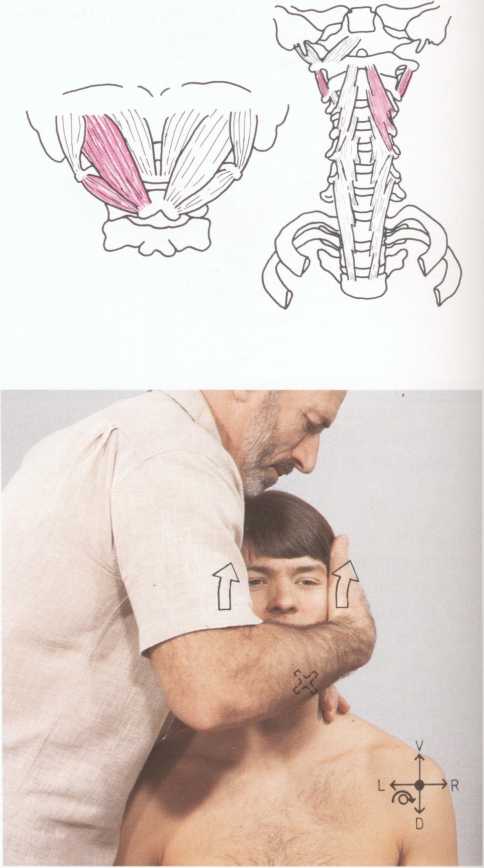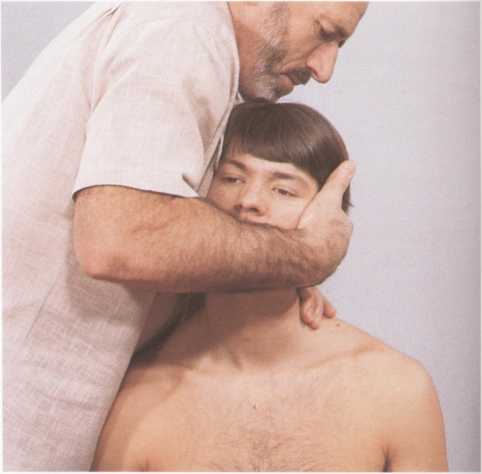76 (203)

3.9.1A. Specific techniąue to increase
rotation to the right of the atlas on the axis
Traction techniąue; P sitting.
Starting Position: P: Sitting; right side of head supported against T’s right shoulder and chest. T: Standing facing P’s right sidc.
Grip: T’s left index finger and thumb stabilize P’s axis, preventing it from rotating to the right. T’s right hand grips the left side of P’s occiput, stabilizing P's head against Ts chest and shoulder. P’s left ear lies comfortably in the palm of T’s right hand, and Ts arm is positioned to prevent discomfort to P’s mandible. T's right little finger lies along the posterior arch of P's atlas.
Procedurę: (Traction is the only treatment ntodal-ity of this techniąue. The procedurę comprises two steps.) Step one: Using this grip, T positions P’socciputand the atlas in fuli rotation to the right (and a slight lateral flexion to the left), thus fully stretching the tissues.
Step two: Maintaining this position, T applies traction between P’s atlas and the axis by moving his/her body together with P's head. These steps are repeated until considerable improvement is attained.
Stimulation of Antagonists: T retains grip, and asks P to look upwards, to the right, and rearwards, and then move his/her head further in the direction just stretched. T resists that move-ment to stimulate P’s antagonists.
Notes: The transverse ligament of the atlas may be pathologically weakened. If so, it must not be strained in treating. T prevents strain by using right shoulder to push P's head dorsally, applying morę force than when rotating with the right hand. This moves P's atlas dorsally. By simul-taneously pressing C2 ventrally, T can press the odontoid process (dens) against the anterior arch of the atlas, preventing pressure on the transverse ligament.
Step two is the key part of the procedurę, as further rotation to the right depends on traction. With slight lateral flexion to the left, the rotation to the right also increases, which prevents the joints from being compressed.
The atlas on the axis is the most vulnerable segment of the cervical spine.
Using this safe, gentle techniąue and slight, gentle forces when rotating, minimizes the risk of therapist error.

Fig. 60 a. Starting Position.

Fig. 60 b. Finał Position.
76
Wyszukiwarka
Podobne podstrony:
72 (211) 3.8.1A. Specific techniąue to increase rota-tion to the right and lateral flexion to the le
77 (197) 3.9.IB. Specific techniąue to increase rota-tion to the right of the atlas on the axis. Tra
Transport?lay blok Błock Parameters: Transport Delay □ i lar ucioy Apply specified delay to the i
36vcu06 RS OCTL.ic - IDD_PROPPAGE_OCTL (Dialog) j • TÓDÓ: Place Controls to manipulate properties of
58 (289) 3.6.1A. Non-specific techniąue to increase dorsal flexion with rotation and later-al flexio
64 (250) 3.7.1A. Non-specific technique to increase dorsal flexion with rotation to the right a
38 (492) 3.3.1A. Non-specific technique to increase ventral flexion with rotation and lateral f
60 (278) 3.6.2A. Specific technique to increase dorsal flexion with rotation and lateral flex-ion to
61 (265) 3.6.2B. Specific techniąue to increase dorsal flexion with rotation and lateral flex-ion to
62 (263) 3.6.2C. Specific techniąue to increase dorsal flexion with rotation and lateral flex-ion to
63 (253) 3.6.2D. Specific technique to increase dorsal flexion with rotation and lateral flex-ion to
65 (245) 3.7.IB. Non-specific techniąue to increase dorsal flexion with rotation to the right a
66 (237) 3.7.1C. Non-specific techniąue to increase dorsal flexion with rotation to the right a
67 (234) 3.7.2A1. Specific technique to increase dorsal flexion with rotation to the right and
68 (230) 3.7.2A2. Specific techniąue to increase dorsal flexion with rotation to the right and
69 (224) 3.7.2B. Specific techniąue to increase dorsal flexion with rotation to the right and l
71 (223) 3.7.2D. Specific techniąue to increase dorsal flexion with rotation to the right and l
więcej podobnych podstron